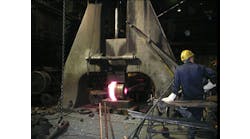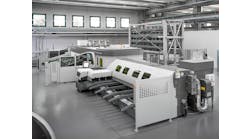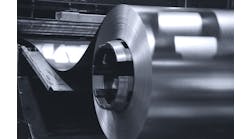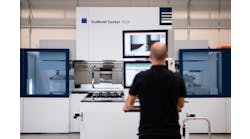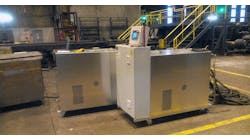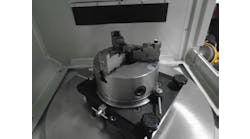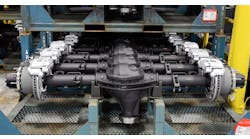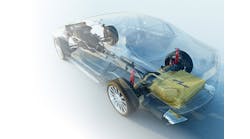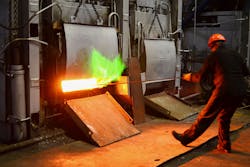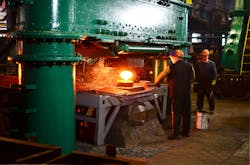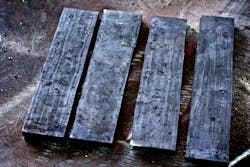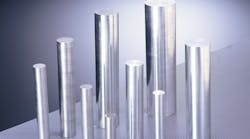Of all structural metals and alloys, aluminum alloys are the most readily forged to precise intricate shapes. There are a number of reasons for this: aluminum alloys are ductile, they can be forged with dies heated essentially to the same temperatures as the workpiece, they do not develop scale during heating, and they require lower forging pressures. The specific forging processes are similar, in some ways, for aluminum and steel...and very different in others.
Most aluminum-alloy bars are supplied as rounds or rectangular shapes suitable for forging. Most bars are extruded from billet or ingot, though at least three producers offer continuously cast, fine-grain bars suitable for direct heating and subsequent forging.
Forging temperatures are very low, being below incandescent temperatures. Thus, temperature controls and furnace construction for aluminum are different from those used with ferrous materials. Radiation-type (infrared) sensors are increasingly used for measuring billet surface temperatures. Most indirect-fired, recirculating air furnaces are controlled by internal thermocouples.
Aluminum does not scale, so there are fewer problems from furnace atmospheres. However, under some heating conditions, "blister" formation is a problem that is traceable to absorbed hydrogen from moisture in the various heating furnaces. Most of these blisters appear during or after solution heat treatment.
There are a few differences in the forging process outlines for aluminum and steel: bars are sawed or sheared into slugs—sawing being preferred for bars larger than two inches in diameter. These pieces are heated in different types of indirect-fired ovens, like furnaces. The pieces are preformed, blocked, and finish forged in progressions that are similar to steels, and the final forgings usually are cold trimmed—but sometimes hot trimmed.
There are significant differences in the design of flash for aluminum versus steel forgings, with it usually being much thinner. Also, the shrinkage allowances are less for aluminum than for steels. (0.126 inches/ foot for aluminum versus 0.375 inches/foot for steels).
Heating
Indirect-fired or electric resistance-type furnaces equipped with internal fans are often preferred for aluminum. These are almost always captive to the lower temperature regimes for aluminum. This means new furnaces rather than modifications for the steel forger contemplating forging aluminum.
Grain size in forgings is highly dependent on the forging reductions and final temperatures but does not show up until after solution heat treatment where serious grain growth can occur if not controlled properly during forging. Unlike steel, there is no grain refinement coming from heat treatment.
Overheating is a serious event and must be avoided entirely. This means controls are even more critical than for steels.
Induction heating has some risks, due to a lack of good measurement systems (although IR systems are improving). Contact temperature measuring is preferred in most cases.
Forging Equipment
Aluminum alloys can be forged in almost all presses and impact equipment, with a few exceptions. Hammer forging of 7075 or 7050 grades must be more carefully performed because of their lower melting temperatures and a tendency for temperature build-up to occur in the forgings during the typically faster deformation rates.
In presses, it's a relatively easy task to heat the dies and support tooling to temperatures close to the forging temperatures (typically 725 to 900°F [385 to 482.2°C], depending on the alloy.) Most die steels will withstand preheating to temperatures up to about 850°F (454.4°C) before they begin to soften. Thus, die temperatures for aluminum forgings typically are controlled in the range of 650 to 800°F (343.3 to 426.7°C) for near-net forging, and a broader range is acceptable for conventional forgings.
Hydraulic presses often are preferred for aluminum because they are the most versatile and slow forging speeds are of little concern, compared to what would be true for steel forgings.
Metal Flow in Aluminum Forging
Aluminum forgings tend to develop surface metal smearing, or "scrubbing," wherein the metal in some areas actually pressure welds to the die steels, and then partially re-welds onto the forging. This occurs especially on die surfaces that are unidirectionally polished in the direction of the predominant metal flow. The obvious solution is to lubricate the blanks and the dies, and especially to polish the dies in the same direction as the metal flows over the die surface.
This "scrubbing" can result in blisters because some lubricant or other contaminants enters into pockets between the loose metal and the base metal. These "scrub" blisters become obvious on reheating. If the dies are tempered at 600 to 800°F (315.6 to 426.7°C) after polishing in the air or in a steam atmosphere, they form an oxide that is very resistant to scrubbing. Once repolished, however, the dies again become prone to scrubbing defects.
It's common also to forge aluminum in more than one heating, with a pickling operation and some surface polishing between blocker forging and finish forging, for example with larger forgings. This is when the conditions described above are removed by polishing.
The closer the die temperatures match the metal temperature, the better the die filling is in deep cavity dies. This is especially true for hydraulic press forging.
Trimming of Aluminum Forgings
Small aluminum forgings can be cold-trimmed in much the same way as steel forgings. Larger forgings can be hot-trimmed or band-saw trimmed, depending on size and configuration. Again, a key problem is with pressure welding of aluminum to the hard edges of the trim dies. Water quenching the forgings immediately after forging improves cold trimming but excessive delays can cause natural aging, thus re-hardening.
Heat Treatment of Aluminum Forgings
Heat treatment of aluminum forgings consists of a solution treatment followed by quenching in water and then an artificial bake-aging cycle for eight to 16 hours at temperatures between 250 and 350°F (121.1 to 176.7°C), depending on the alloy. Again, the furnaces are more like those used for tempering steels for the solution cycles and simple, low-temperature ovens for the aging cycles.
Metallurgical Quality Issues
Ultrasonic inspection methods (longitudinal wave) generally are used to determine the internal soundness of aluminum forgings. Coarse grain sizes can cause variations in penetration and defect resolution. Most harmful internal defects can be detected with these methods.
Some near-surface defects are not readily detected, however, and must be checked with a shear wave testing program. Surface defects can be detected visually after a suitable etch inspection, followed by suitable penetrate techniques.
Blisters are obvious in patterns of small bumps on the surface of forgings. These must be removed by polishing, making certain not to compromise dimensional integrity. As a general rule, it's best to determine the extent of the blistering first and, if it's excessive, the full lot of affected forgings could be subject to rejection.
There are three notable blister types:
- Scrub blisters, where the surface layers are separated with lubricant-black underneath the blister. Such blisters usually are seen in a repeating pattern.
- Hydrogen blisters, where excessive hydrogen is absorbed during the heating and heat treating cycles; the metal is usually white underneath the blister. Blisters are not located in a repeating pattern but are random, usually on thinner sections.
- Burned metal blisters, where the metal overheats. Again, these usually are located in a pattern associated with the largest reductions. The underlying metal usually appears to be gray.
These last two types of blisters are a sufficient cause for rejection and should not be polished out. Such parts should be rejected at the forge plant.
Dimensional Quality, Distortion, and Residual Stress
Aluminum forgings are produced in a variety of die shapes, including no draft and flashless configurations. This is partly because the dies are readily heated to temperatures that are similar to the aluminum blank material. Aluminum shrinks less than steel and does not undergo the transformation-related expansions that steels do. This means that the parts will likely be very similar to the forging dies. When the dies are correct dimensionally, the forgings are correct. Also, since dies wear very slowly, they last for many forgings without dimensional changes caused by tool wear.
Often, tools will experience wear out as a result of excessive polishing to remove pressure-welded aluminum from the die steels. This is why a good parting compound applied to the preforms minimizes this cause of tool wear-out.
Distortion During Subsequent Machining
This problem, discussed earlier, requires further comment. It has not been fully resolved for large forgings, nor for some smaller forgings that have very thin sections, before heat treatment. The practice of cold re-striking has done much to ensure dimensional stability for most small forgings.
After heat treating at the corresponding thermal cycles for each alloy grade, the forgings are ready for machining. Some variations include heat treatments of T652, or T651, where the forgings are cold-deformed with tensile or compressive stresses and with very light reductions. These treatments tend to reduce distortion and/or stress-corrosion cracking in service. Any of these processes for impression die forging is that they require further steps and handling—and thus add costs.
Residual Stress
A significant problem with heat-treatable aluminum forgings is the residual stresses imposed by quenching and sometimes by straightening just after quenching. The aging temperatures usually are too low to adequately remove the residual stresses, which, in some cases, exceed 30,000 psi. Residual stresses often cause warpage during machining and promote stress corrosion.
Partially successful approaches to these problems include:
- Quenching into boiling water to minimize residual stresses
- Cold coining or peening to lower the residual stresses
- Reverse quenching to cooling solution-heat-treated forgings slowly to extremely low temperatures after quenching, then reheating them rapidly by steam, hot water, hot dies, etc.
The theory behind these methods is that residual stresses can be minimized by imposing stresses essentially equal to but opposite to the original quenching stresses.
Lubrication
Lubricants used for aluminum-alloy forgings vary from kerosene to oil-graphite suspensions, to complex, proprietary commercial compounds. Forging companies frequently mix many of these with one or more oils, and some companies permit individual press operators to modify the mixtures slightly for ease of application. Hence, it's difficult to apply a precise rating to the many possible lubricants.
In general, the graphite suspensions applied by spraying are preferred for press forging, while water-soluble soaps applied by swabs are frequently used for hammer forging. Another technique consists of dipping aluminum forging blanks into a caustic solution (10% NaOH) to produce a porous conversion coating on the surface. Then, the forging blanks are dipped into a slightly acidic colloidal graphite dispersion and dried prior to forging.
This technique eliminates many of the seizing and galling problems but adds to the problem of corrosion if the forgings are not cleaned soon after forging. The result is a copper-rich surface on copper-containing alloys like 2014 or 2025. This serves as an excellent lubricant as well.
Blisters
Aluminum alloys are susceptible to blister or void formation near the forging surface. These defects usually are observed after solution heat treatment. There are at least three types of blisters found on forged aluminum. When the blisters are opened with a pointed tool, the inside surfaces appear to be gray, dark brown/black or white.
These colors generally identify blisters caused by, respectively:
- Incipient melting
- Improper lubrication
- Dissolved gases
The first type is observed where solution heat-treating temperatures are too high. The second type of blister forms when inadequate lubrication causes the surface metal to seize and shear away from the subsurface metal. Lubricants trapped below the surface volatilize during heat treatment, causing blisters. These blisters are most frequently found on the edges of blades and portions of other forgings characterized by the rapid metal flow.
The third type of blister is not fully understood. The most popular theory holds that atomic hydrogen, accumulated during melting, fabricating, and heat treating concentrates in lattice imperfections, and then changes to the less-soluble molecular form. Further, it's believed that the blisters form when the trapped gas expands during the solution-annealing cycle.
Whatever the true origin of the gas-type blisters, they can be prevented by applying commercial, water-soluble corrosion inhibitors to the forgings before heat treatment.
Another theory about these last blisters is that any serious exposure to products of combustion in the heating furnaces for forging or heat treating can promote hydrogen pick-up. This is one reason that furnaces heated with electric elements, induction or in indirect gas firing, are preferred.
Forging Design
In principle, aluminum alloys can be forged to any shape consistent with limits set by die design. In the past decade, for example, forging companies developed a no-draft precision forging that requires little to no preassembly machining. Tooling costs for such forgings are considerably higher than for more conventional designs, and so precision forgings should be specified only where the tooling costs can be amortized over large production quantities.
A frequently quoted rule is that a production order should total 500 forgings or more for precision forging to be economical. This figure will vary according to the balance between final machining-cost reductions and tooling-cost increases. Most forging companies will provide estimates of both conventional and precision designs so that a direct cost comparison can be made.
The U.S. Air Force's heavy-press program made possible the closed-die forging of aluminum-alloy parts up to 20 feet long. There are at least three presses in the U.S. with capacities of 50,000 tons or greater. Vertical ribs 1/8 inch thick with zero draft have been forged successfully on aluminum parts weighing over 50 pounds. These same parts have thin webs ranging from 3/16 to 1/4 inches thick.
Maximum limits on forging size depend a great deal on the precision requirements and final techniques but, as a rule, the maximum forging size (plan area) is in the neighborhood of 3,500 square inches for aluminum die forgings.
Small forgings may vary down to a few ounces, which may be forged in platters or multiple impressions per die. A critical factor in designing small forgings is the grain-flow patterns.
For example, a horseshoe shape can be forged in platters but if the grain-flow pattern is not bent to follow the part contour, there could be losses in ductility. This is because aluminum forgings are generally dependent on grain direction for maximum ductility. To explain further, elongations well over 15% can be typical for longitudinal grain-flow patterns while the corresponding transverse elongations might be as low as 5 to 6%.
Because aluminum alloys are not sensitive to scale formation or contamination, excess stock allowances are necessary only to obtain dimensional accuracy and provide for localized deviations. Often, precision forgings are forged to final size and require no excess stock allowances.
Metallurgical Design Factors
Because some alloys (notably 6061 and 2014) are subject to excessive grain growth, the problems of grain-size control require carefully balanced reductions, forging temperatures, and die temperatures. Frequently, close-tolerance forgings receive only small reductions during the final stages of forging at comparatively low temperatures and are likely to exhibit abnormal grain growth upon subsequent solution heat treatment. This is rarely a problem with forgings more conventional in design.
For more than 40 years H. James Henning held key technical positions in the forging industry, including as director of technology for the Forging Industry Association, and as president of Henning Education Services, a Columbus, OH, firm specializing in customized education and training in forging technologies.

